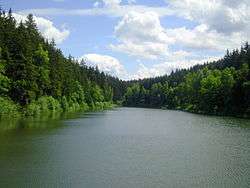Head (hydrology)

The head (German: Stauwurzel) is the point on a watercourse, up to which it has been artificially changed by an impoundment. Above the head of the reservoir, for example, natural conditions prevail; below it the water level above the riverbed has been raised by the impoundment and its flow rate reduced.
In principle, a distinction must be drawn between the head of a reservoir impounded by a dam, and the head of a works resulting from a barrage or canal locks.
Head of a reservoir
The actual location of the head varies with the height of the water level in the dam. Since there is only an extremely low flow velocity within the reservoir and therefore no water level gradient is present, the head can be clearly seen with the naked eye: this is where the stream meets the reservoir.
Upstream of the actual reservoir, there is often a so-called pre-dam. Pre-dams typically have a constant water level so the head is clearly defined.
Head of a works
On large rivers, the head of a works is difficult to ascertain, because, even within the impounded section, there is a significant flow rate and water level gradient. The head can only be found by calculation or defined by observations with and without impoundment. Depending on the flow rate and control of the barrage, locks or weir, the position of the head will vary considerably and will not necessarily be where the so-called headworks are located.
Many rivers (eg the Moselle) are barraged several times in order to make them navigable or to avoid uncontrolled flooding. In such a case, there is often no part of the river that is uninfluenced by artificial impoundment and thus no 'head'.